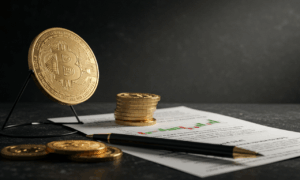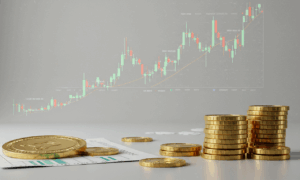Actively managed ETFs are gaining significant attention in the investment world, and a recent move by a Wall Street giant is making waves. For anyone looking to grow their wealth, understanding the evolving landscape of investment products is key. A new fund has just been launched that blends a classic investment strategy with the modern structure of an Exchange-Traded Fund (ETF), and it’s worth taking a closer look at what this means for everyday investors. This article will break down this development, explain the core concepts without the jargon, and help you understand how these products fit into the broader world of personal finance.
Before we dive into the specifics of this new product, let’s establish a clear foundation. What exactly is an ETF, and why have they become so popular?
A Quick Refresher: What is an Exchange-Traded Fund (ETF)?
Think of an Exchange-Traded Fund, or ETF, as a basket of investments. Instead of buying just one company’s stock (like Apple or Amazon), an ETF allows you to buy a whole collection of assets—stocks, bonds, or commodities—all in a single transaction. This basket is then traded on a stock exchange, just like a regular stock, meaning its price can fluctuate throughout the day.
The primary benefits of ETFs that have attracted millions of investors include:
- Instant Diversification: By buying one share of an ETF, you gain exposure to dozens or even hundreds of different companies. This spreads out your risk, so if one company in the basket performs poorly, it has a smaller impact on your overall investment.
- Transparency: Most ETFs are required to disclose their holdings daily, so you know exactly what assets you own.
- Flexibility and Liquidity: You can buy and sell ETFs throughout the trading day at the current market price, offering more flexibility than traditional mutual funds which are typically priced only once per day.
Traditionally, the vast majority of ETFs have followed a passive investment strategy. This is where the new development becomes particularly interesting.
The Great Debate: Active vs. Passive Investment Management
To understand the significance of this new fund, we need to explore one of the most fundamental concepts in investing: the difference between active and passive management. These are two distinct philosophies on how to manage a portfolio of investments.
Passive Management: Riding with the Market
A passively managed fund, whether it’s an ETF or a mutual fund, doesn’t try to be a hero. Its goal is not to beat the market, but to match the performance of a specific market index. The most famous index is the S&P 500, which represents the 500 largest U.S. companies.
Think of it like getting on a tour bus that follows a predetermined route (the index). The driver isn’t trying to find clever shortcuts; they are simply sticking to the map. The main advantages of this approach are:
- Low Costs: Since there isn’t a team of analysts constantly researching and making trades, the management fees (known as the expense ratio) are typically very low.
- Simplicity and Predictability: You know exactly what you’re getting—the performance of the market index, minus a tiny fee.

Active Management: Trying to Beat the Market
This is where active management comes in. An actively managed fund is run by a professional portfolio manager or a team of analysts. Their job is to conduct in-depth research, analyze market trends, and hand-pick investments they believe will outperform a benchmark index like the S&P 500.
To use our analogy, this is like hiring a professional driver in a sports car. They are actively looking for shortcuts, avoiding traffic, and trying to get you to your destination faster than anyone else. The potential benefits are clear:
- Potential for Higher Returns: If the fund manager makes the right calls, the fund can generate returns that are significantly higher than the overall market.
- Risk Management: In a declining market, an active manager can shift investments into more defensive assets to potentially reduce losses.
However, this strategy comes with its own set of trade-offs, namely higher fees to pay for the expertise of the management team and the risk that their decisions might not pay off, leading to underperformance.
The News Explained: A Major Player Enters the Active ETF Arena
Recently, financial giant JPMorgan launched a new actively managed ETF focused on U.S. large-cap stocks. Let’s break that down. “Large-cap” refers to large, well-established companies with a high market capitalization (think household names like Microsoft, Johnson & Johnson, or Visa). These are often seen as the bedrock of a stable, long-term portfolio.
By creating this product, the firm is betting that investors want a vehicle that combines the trading flexibility of an ETF with the potential to outperform the market that active management promises. The fund’s managers will use their research and expertise to select a portfolio of large-cap stocks that they believe are poised for strong growth, rather than simply buying all the stocks in an index. This move is significant because it adds another high-profile option to the growing roster of active ETFs, signaling a broader industry trend toward these hybrid financial products.
What This Means for Your Investment Strategy
The launch of this and similar funds provides more choice for the everyday investor. If you are someone who believes that expert analysis can lead to better-than-average returns but you also value the liquidity and structure of an ETF, then the world of active ETFs might be worth exploring.
However, it’s crucial to approach this with a clear understanding of the risks. The higher fees associated with active management can eat into your returns over time, and there is no guarantee that the fund manager will succeed in beating the market. Historical data shows that a majority of active managers fail to outperform their passive index counterparts over the long run.
Disclaimer: This article is for informational and educational purposes only and should not be considered investment advice or a recommendation to buy or sell any security. Always conduct your own research and consider consulting with a qualified financial advisor before making any investment decisions.
Your choice between active and passive strategies should align with your personal financial goals, your timeline for needing the money, and your comfort level with risk. For more on building a sound financial future, you can explore topics on investment and wealth creation.
The Bottom Line
The financial world is constantly innovating, and the rise of the actively managed ETF is a perfect example of this evolution. This latest launch from a major institution underscores a growing demand for investment products that offer something different from the standard index fund. By understanding the core differences between active and passive management, you empower yourself to make more informed decisions that are better suited to your unique financial journey. As always, the key is to look past the hype, understand the mechanics of any investment product you consider, and build a diversified portfolio that you are comfortable with for the long term.
Frequently Asked Questions (FAQ)
Is an actively managed ETF a riskier investment than a passive one?
It’s not necessarily “riskier” in the traditional sense, but it carries a different type of risk. The primary risk of an actively managed ETF is underperformance risk—the risk that the fund manager’s decisions will cause the fund to perform worse than its benchmark index. A passive ETF, on the other hand, is designed to closely track its index, so its main risk is broad market risk. If the entire market goes down, the passive ETF will go down with it. With an active fund, you are betting on the skill of the manager, while with a passive fund, you are betting on the market as a whole.
Why would I pay higher fees for an active ETF if most don’t beat the market?
That’s the central question in the active versus passive debate. Investors choose active funds for the potential of outperformance. While many active funds fail to beat their benchmarks over the long term, some do succeed, and sometimes by a significant margin. Investors who are willing to pay higher fees are doing so in the hope that they have chosen one of the skilled managers who can navigate market complexities, identify undervalued assets, or manage risk more effectively than a simple index-tracking algorithm could. It is a calculated decision based on a belief in a particular manager’s strategy and skill set.



